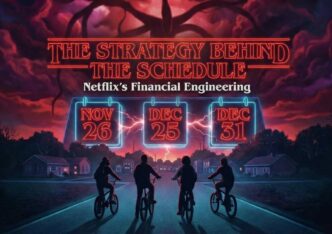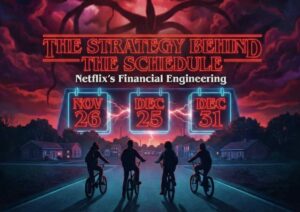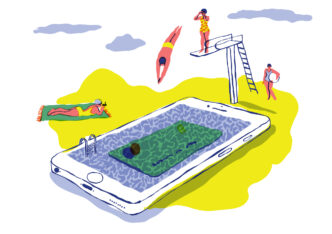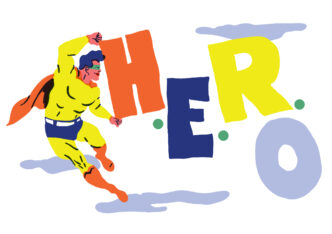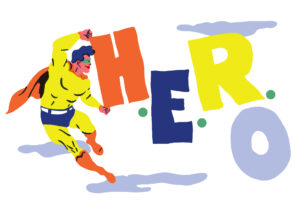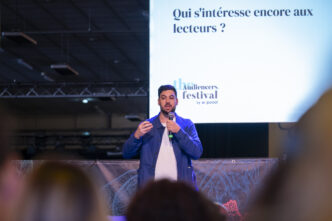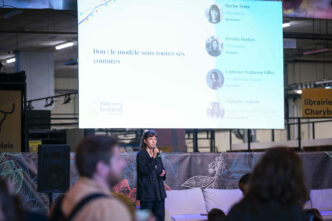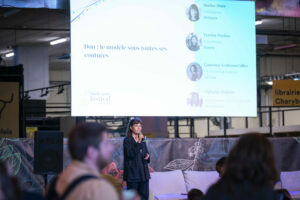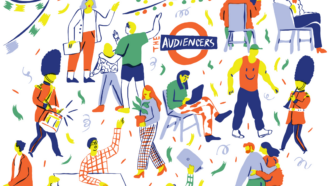
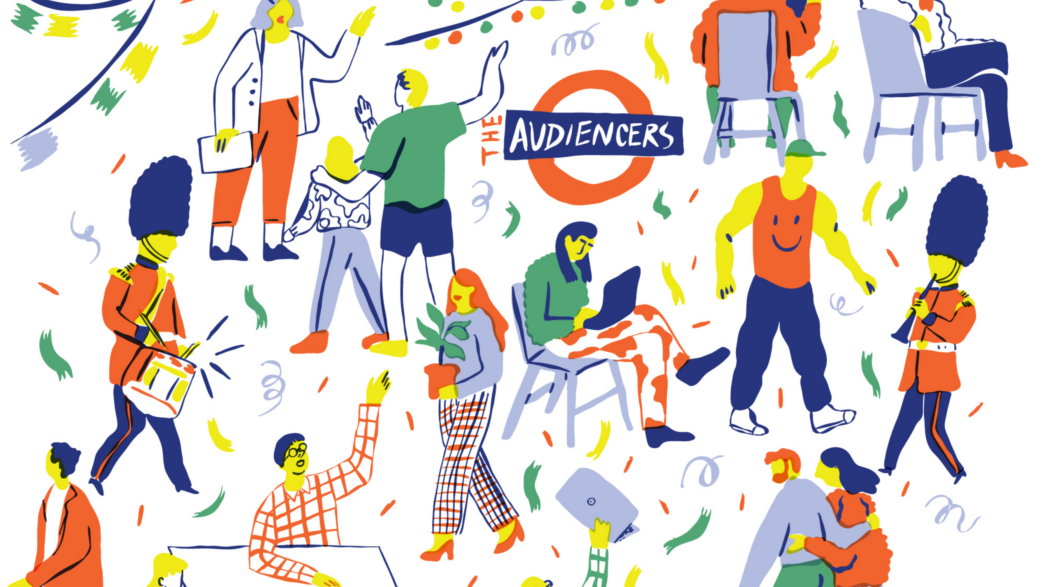
Our first session at The Audiencers' Festival in London last week did not disappoint, with 145 digital publishing professionals the afternoon was filled with insightful conversations both on and off stage. To reflect this, we're publishing not just one, but a series of takeaway articles from the event!
Kicking the day off: How bridge roles can be used to bring editorial, marketing and product together to increase ARPU
On the panel:
- Martina Andretta, Head of Social at the New Statesman
- Lars K. Jensen, Audience, data & journalism at Berlingske Media
- Dmitry Shishkin, Independent Publishing Consultant
“Bridge role”, a concept that existed without a name for a long time but one that reflects the shift towards subscription as a revenue model. One where teams need to come together to put audiences first from every angle, representing and aligning interests across the company.
But how can publishers succeed in developing or improving a bridge role? Our 3 panelists share their perspectives on some of the essential models, stragies and structures needed for success.
1. Internal alignment
Martina is Head of Social at the NS, a role that developed into a bridge fairly organically as she works increasingly between editorial, and everyone who isn’t editorial – data, tech, product, and other brands in the NS Media Group.
For Martina, one of the biggest challenges for those in a bridge role to tackle is internal alignment. Getting all teams working towards the same goals, speaking the same language and, in the case of subscriptions, understanding the value of their work in the same way (e.g. an article written for high page views vs high conversion rates).
Simply building a timeline of the title’s changes over the years proves why alignment is a challenge… With digital transformation and the shift from advertising to subscription-based revenue models people within the company have been required to make significant changes in their day-to-day work.
Thus came the realization that an audience team was essential for success in these subscription projects, ensuring teams talk to each other in a productive and regular way necessary to align and advance in projects.
First steps in this role to ensure alignment:
- Define your value proposition and North Star with senior management. Repeat this often during meetings to ensure everyone’s working towards the same goal
- Identify the customer by carrying out audience reviews
- Get everyone in the same room. Set regular catch-ups, get invited to meetings to understand other team’s mindset, review as regularly as possible
- Get to know the team. In practice, listen! Other people’s frustrations can often offer the solution to the challenges you are facing
A case study example of aligning teams
With the integration of paywalls and registration walls into articles came the need to ensure teams were working towards the same goal. For example, the audience team worked with editorial to define the KPIs for success, moving from a purely advertising (reach) focus, to also writing for conversions. I.e. ensure there’s a mutual relationship between the wall and article, rather than one being dependent on the other.
The project: a data-led approach to commissioning stories
The challenge: different teams were working on different goals, understanding what success looks like.
The solution: long-tail analysis.
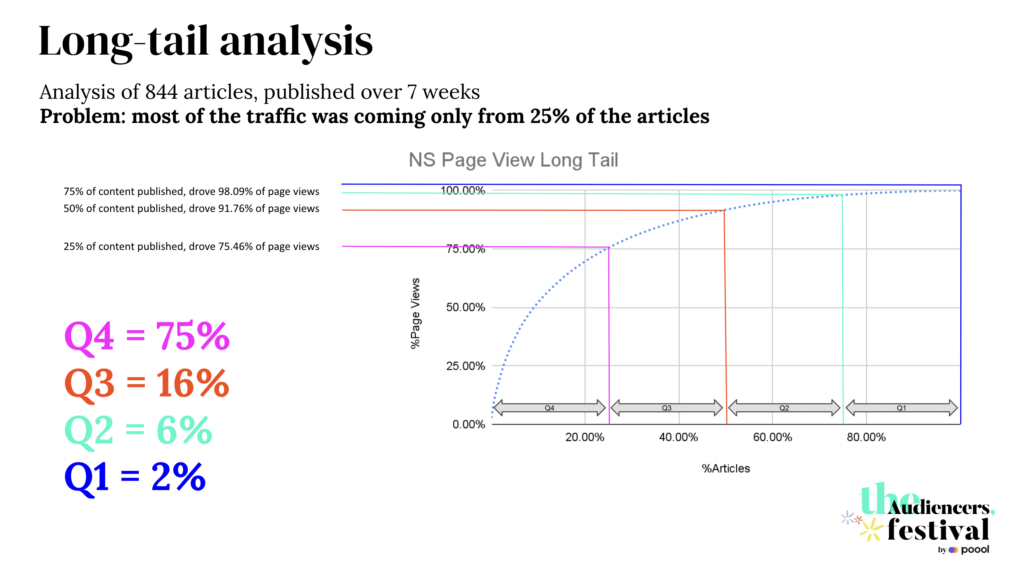
In practice: the team analyzed 844 articles published over 7 weeks (taking out any ‘huge hits’ that might skew the data) with the goal of looking at content that performed well in terms of both page views and conversions (note that the graph above only shows the page views analysis).
For example, the above graph, looking at page views, revealed that most traffic was only coming from 25% of articles. I.e. 75% of articles were doing nothing for the NS business.
After this analysis, on both PVs and conversions, articles were placed on a chart to discover which content performed well for both metrics: page views (visits) and conversions (subscriptions).
For articles falling into the “Under performers” category, that’s where work needs to be done to ensure it supports to at least one business goal.
This analysis and chart was developed for every editorial category so the audience team could speak with every editor to have regular catch-ups, understanding what was and wasn’t working, trends, etc.
For instance, the culture team took the advice on board, optimizing the performance of each article for these 2 goals. The result was that they ended up publishing fewer articles but with higher page-views and conversions.
But, importantly, this success helped to get other teams on board. The culture team became brand ambassadors to prove that the analysis and changes made were working. They also organized regular meetings with editorial and data teams, as well as establishing lines of accountability – having some kind of backing from senior management.
What needs more work? Clear roles and responsibilities (fairly hard in a small team, but this makes it all the more important to manage correctly), as well as moving away from legacy workflows, working towards a more circular model where data analysis and feedback informs the planning/commissioning (where everyone is involved) before the editing, design, etc. thus helping to better align teams.
Martina’s key takeaways:
- If you are thinking of introducing a bridge role: look around the newsroom. Often people with the right skillset are already part of your organization, and may only need further training or support
- If you are in a bridge role: get to know people. Bridge roles can have levels of seniority, but being respected and listened to is key.
- If you are in a bridge role: if there’s an area you know less of, get yourself invited to their regular catch-ups
- If you are starting out in a bridge role: bring concrete examples of how your work has made a difference and how it could make other people’s jobs easier
> To add to your reading list: The Audiencers’ Festival in Paris according to Marion: the ‘best ofs’ from our event
2. User needs at Berlingske Media
The audience team at Berlingske Media is made up of 3 people who together own the user facing features like paywalls, registration walls, user journeys, flows etc. and working with every part of Berlingske Media.
Lars’ role specifically:
“To work together with our newsrooms and editorial staff to ensure that we develop and present our journalism in a way that is relevant to our audience and generates value to us as publishers.”
User needs use case
The project: produce content with a user need in mind, understanding which user needs are best for achieving business goals such as subscriptions
The challenge: too many articles weren’t converting.
The solution: a year of user needs projects! Helping teams to understand the different ‘needs’ and using it as a prism for analyzing stories with the goal of converting readers into subscribers (focus was therefore on the title, sub-heading and first 2 paragraphs).
Putting this model into practice has taken a year – starting with analysis and presentations, buy-in from editorial teams at each title and workshops with each department (for instance with exercises to understand the user need that each article falls under). It was also essential to use this time to develop a shared language on user needs and understanding audiences across titles. I.e. What is a connect me story? Does everyone agree on this definition?
The final step to put the changes and work into practice was to translate this to journalism.
This research revealed that some needs are very effective at converting, but are under-served (and vice versa). For example, whenever an “update me” story was published, the number of conversions also went up.
What needs more work?
Cultural change – “It’s so very hard!”… but here are 3 tips to help success.
- Get buy-in from management: it will give you both leverage and confidence in what you are doing and trying to achieve
- Find a clear narrative and stick to it, don’t have 10-15 points on how user needs can improve journalism. Instead start with 2-3 and really make it concrete to editors, showing why and how it works.
- Find out what success is for others and help them achieve it (the social aspect of jobs to be done) – when are your colleagues succeeding? How can you help them achieve that with the user needs project?
What next?
Strategy execution
4 important pillars for executing strategy:
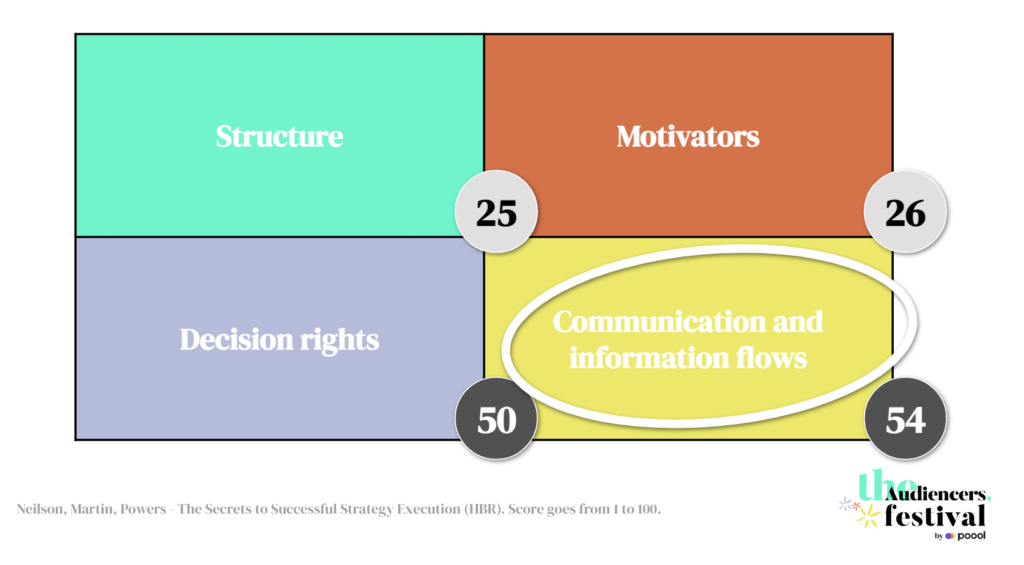
Structure is actually not the most important, rather communication and information workflow – How are people talking to each other? Is the right data going in the right places? Where does one person’s work end and another’s begin?
Smarter collaboration
Bridge roles are also about designing how people can work better together, being the one who actually acts to put the bridges into practice, rethinking existing roles and structures.
“Yet our data suggest that publishers whose corporate structures house product and analytics functions in centralized parts of the organization, even while their newsrooms are decentralized, have difficulty fostering the kind of on-the-ground, close-to-the-reader collaboration between disciplines needed to make a reader revenue strategy really work.
[…]
So what can legacy publishers do to create structures that drive reader revenue? Structure doesn’t have to mean just relationships on an org chart. Sometimes rethinking existing roles and workflows can be a solid first step towards larger structure changes.“
Columbia Journalism Review / Tow Center
To do this at Berlingske Media Group, Lars and his team have now developed forums in the middle of all teams from the 4 groups, one for advertising and another for logged users, with representatives from each title. The goal here is to first develop their strategy in a sustainable manner, learning from each other and bringing expertise together before executing in each title.
3. Bridge roles move your organization forward
Dmitry, Independent publishing consultant and “influencer” of the industry, particularly when it comes to bridge roles and user needs, was the final panelist to take to the stage, discussing some of the essentials for success in bridge roles based on his experience.
Start by relaxing decision makers
People are naturally averse to change, but change is your friend disguised as your enemy!
Words matter – you need a common vocabulary
If you describe the same thing differently across multiple teams it’ll be like you’re talking about different things. Instead of competing for the “right” language, collaborate and explore a new shared language.
Train people to go from one part of the organization to another
By moving between teams and understanding various goals and what “success” looks like, your people will gain respect and trust from teams.
Those in bridge roles need soft skills and to be able to communication easily
Bridge rolers are in the “people” business, and good communication skills are essential:
- Needs to have a deep understanding of the organization of the company & its values
- Needs to be respected by all teams – socializing is very important; get to know people in their everyday lives. So you need to be up for that
- Will wear lots of hats, so should enjoy constant change & development
- Keen to learn – humble to not understand something (similar to project managers)
- Listener & leader – good communicator who isn’t afraid to say no, having a narrative over what needs to be prioritized to achieve business goals
- Patience – not always a directly rewarding role, has to evaluate whether something is worth continuing
- Should be able to translate between teams – teams use different languages, so those in bridge roles should be able to help translate but also connect the two, help them understand each other
- Be bold, use data and tell stories. If something is obvious and no one can see it (or don’t have the time), think of how you can visualize it with data, tell it as a story or something else. And present it to the right people in the right context. If you firmly believe in something, giving up should be the very last resort ;-)
Tolerance to fail if lessons are learned
For example, back in 2016, Dmitry worked on a BBC hackathon project in Africa. Whilst the products launched weren’t successful, it did allow the BBC team to learn some important lessons, both internally and externally.
1. Listen to audiences, and then listen again, using these learnings to be more precise in task-setting
2. Try new things, but make decisions quickly – listening to audience feedback also helped us to drop one idea and take another further and then scale it from one regional solution to several international ones
3. Prepare: things do still take time.
4. Get the team environment right, people need to be flexible to make it work
5. Understand what you get into – for instance, in this project, Africa includes many emerging markets with talented developers, many of whom are working within digital start-ups and have little free time
The takeaway: part of a bridge role is having the confidence to try new things, accepting that you may succeed in a way that you weren’t expecting.
Integrating user needs is a typical bridge role task
But to ensure success, all teams need to be involved. They need to understand what user needs are and how to push in the same direction.
More on bridge roles:
- What are bridge roles in media organizations?
- From problem solver to innovator: how bridge roles have evolved in newsrooms
- The rise of bridge roles in news organizations
If you missed out first Festival, make sure you’re signed up to our newsletter to be the first to hear about our next event!

